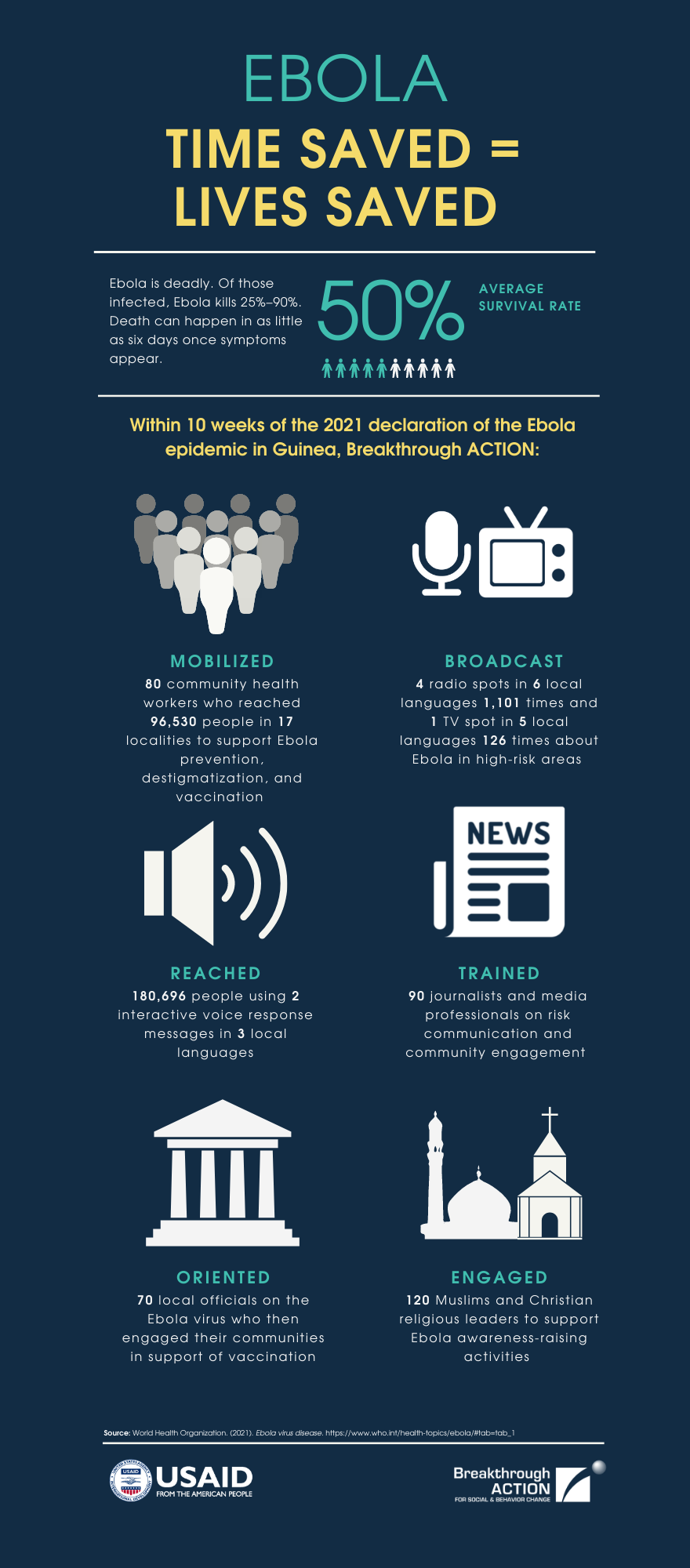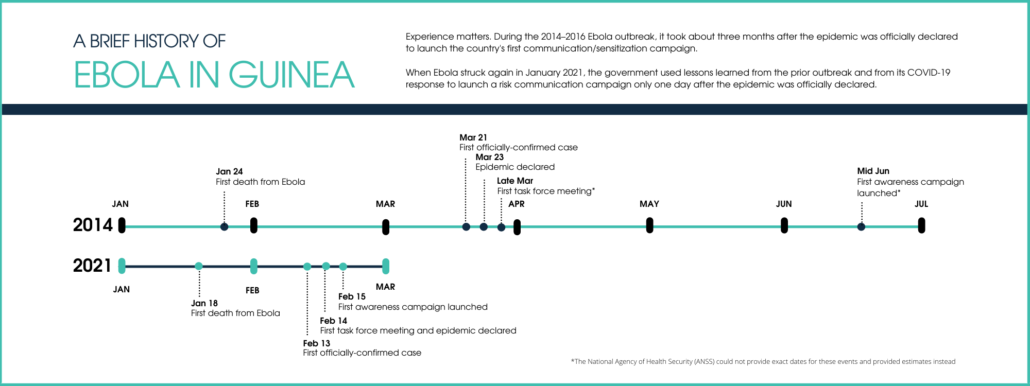TIME SAVED EQUALS LIVES SAVED
Written by: Antonia Morzenti, Program Officer
Infographics by: Meei Child, Communications Officer
As COVID-19 monopolizes news headlines and pandemic hot spots continue to pop up all over the world, some countries are battling a concurrent epidemic within their borders.
On February 14, 2021, Guinea reported a cluster of Ebola cases to the World Health Organization after being Ebola-free for more than four years. Although Ebola is not as contagious as COVID-19, it is far deadlier.[1] Swift action is a matter of life and death. Fortunately, Breakthrough ACTION was well placed to act quickly.
Since 2018, Breakthrough ACTION has been working with the government of Guinea and other partners through the Global Health Security Agenda (GHSA) to strengthen Guinea’s capacity to prepare for and respond to infectious disease threats such as an Ebola outbreak. Focused on improving systems for risk communication, strengthening internal and external partner coordination, and expanding public communication and engagement with communities among other areas of action, Breakthrough ACTION’s GHSA preparedness work and experience responding to COVID-19 pandemic provided a foundation of valuable experience to swiftly respond to the February 2021 Ebola outbreak.
In just three months, Breakthrough ACTION alongside government and local partners launched a mass media campaign with audio and video spots in local languages and interactive radio shows for listeners to call into. Additionally, the project trained journalists and community health workers to inform local communities how to protect themselves against Ebola. Breakthrough ACTION has also worked with respected community leaders to raise community awareness about the virus and the importance of vaccination. (See the infographic at left for outcomes of these and other activities.)
There is little doubt that this rapid response has saved many lives. Three key lessons have emerged from Guinea’s preparedness and response activities.
Lesson One: Know the who, where, what, how, and when
Have an action plan in place before you need it. This plan must spell out:
- Who the relevant stakeholders are at the national, state, prefectural, and community levels.
- Where stakeholders must collaborate for optimal outcomes at each stage of the response work.
- What each stakeholder is responsible for.
- How they can work together.
- When each stakeholder should be involved at any point of the crisis response.
In an urgent situation such as the Ebola epidemic, it is essential to avoid duplicating efforts or reinventing the wheel. Risk communication and community engagement teams should know what is going on around them.
Lesson Two: Build on existing resources
When disaster strikes, there is no time to build relationships and capacity from scratch. Look back on relevant work. Is there an existing network of people that can be tapped to reach affected communities? Is there an existing supply chain that can be leveraged to distribute supplies? Are there existing communication channels that can quickly disseminate information? What messages have been used in past (or similar) situations? Are the messages relevant?
Lesson Three: Invest in communities
Anyone in the community can be a part of an emergency response. Equip community members with what they need to be agents of change before the need arises. Who are the community leaders and with whom do they need to be connected so they are prepared to act when a crisis strikes? What information do community members need to protect themselves and their loved ones? What are their major concerns and fears? Find out what their needs are and address them or invest in them from the beginning.
As climate change continues to drive the expansion of zoonotic diseases, these diseases will most likely strike again. In Guinea, the lessons learned from the outbreaks will continue to feed back into other preparedness work and improve future risk communication planning, coordination, and interventions. If we are to weather future outbreaks, we must continuously learn from our past experiences and from one another.
[1] R0 of Ebola is 1.51–2.53 while R0 of COVID-19 is 1.5–3.5 (https://sph.umich.edu/pursuit/2020posts/how-scientists-quantify-outbreaks.html)



